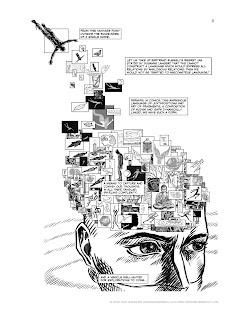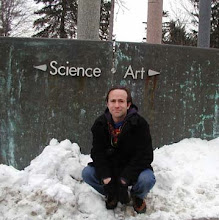Plugging away at Chapter 5, addressing the imagination as way of seeing. (I posted the
opening to the Chapter here.) Given that the entire work is taking up the ways in which we see as metaphors for how we think and how we learn, for this chapter I want to explore the link between perception and imagination. I'd almost introduced
saccadic motion in the previous chapter, but it didn't quite work, and it fit neatly into what I was exploring here. Briefly, saccades are the rapid movements are eyes make several times a second, where they fix on a target and then zip off and focus on another. As Pelaprat and Cole (and others) surmise, it is the imagination that fills in the gaps, that creates a seamless whole from all these disconnected fragments. (I recommend their article "Minding the Gaps", which also discusses
Scott McCloud's idea of the gaps in comics! It's
available in its entirety here.) (Also, I did discuss saccadic motion in a piece I did a few years back, coincidentally titled
"Mind the Gaps" as well.) Anyhow, I wanted to draw the link between the work on eye movements, touched off by
Alfred L. Yarbus, and transform the map of tracked eye movements into a picture. I did my best to estimate the sequence of movements Yarbus had tracked and overlaid them on a rather famous face, and proceeded to draw sixty separate little squares from there, before building it up into the single image at bottom. As a side note, I'd like to see this animated, with the map of movements alongside the developing picture. Perhaps...
Also, what's a chapter on Imagination without words from Maxine Greene? Well, she's actually on the page prior, which I didn't post, though the words on this page "to encounter" reach back to what I cited "Is it not imagination that allows us to encounter the other as disclosed through the image of that other's face?" The reason for using this famous face here, is also a call back to Maxine's passage. Click
here for my comic on Maxine.


The second excerpt here (and note that these are not consecutive pages), is a rare directly personal note in this narrative, (a previous one introduced my
dog's sense of smell as a way of seeing). Here I give Lockerman, the superhero I created in junior high, a brief cameo, to discuss a different aspect of the imagination, and eventually these seemingly separate views will weave together. He appeared also briefly
in my piece "Bi(bli)ography" and some similar themes will crop up here. And what's a dissertation if you can't draw at least one superhero in it!? A curious note, in his earliest outings, Lockerman often referred to his rather outlandish headgear as originating from a windmill he'd met, and despite my not having read Quixote at the time, those early adventures were rather Quixotic. Also, I'm frequently asked what my next project will be after the dissertation - to which I occasionally respond - to draw a superhero comic. While that may not end up being the case, it's fun to revisit an old friend. Onward - Nick


























































